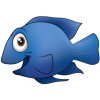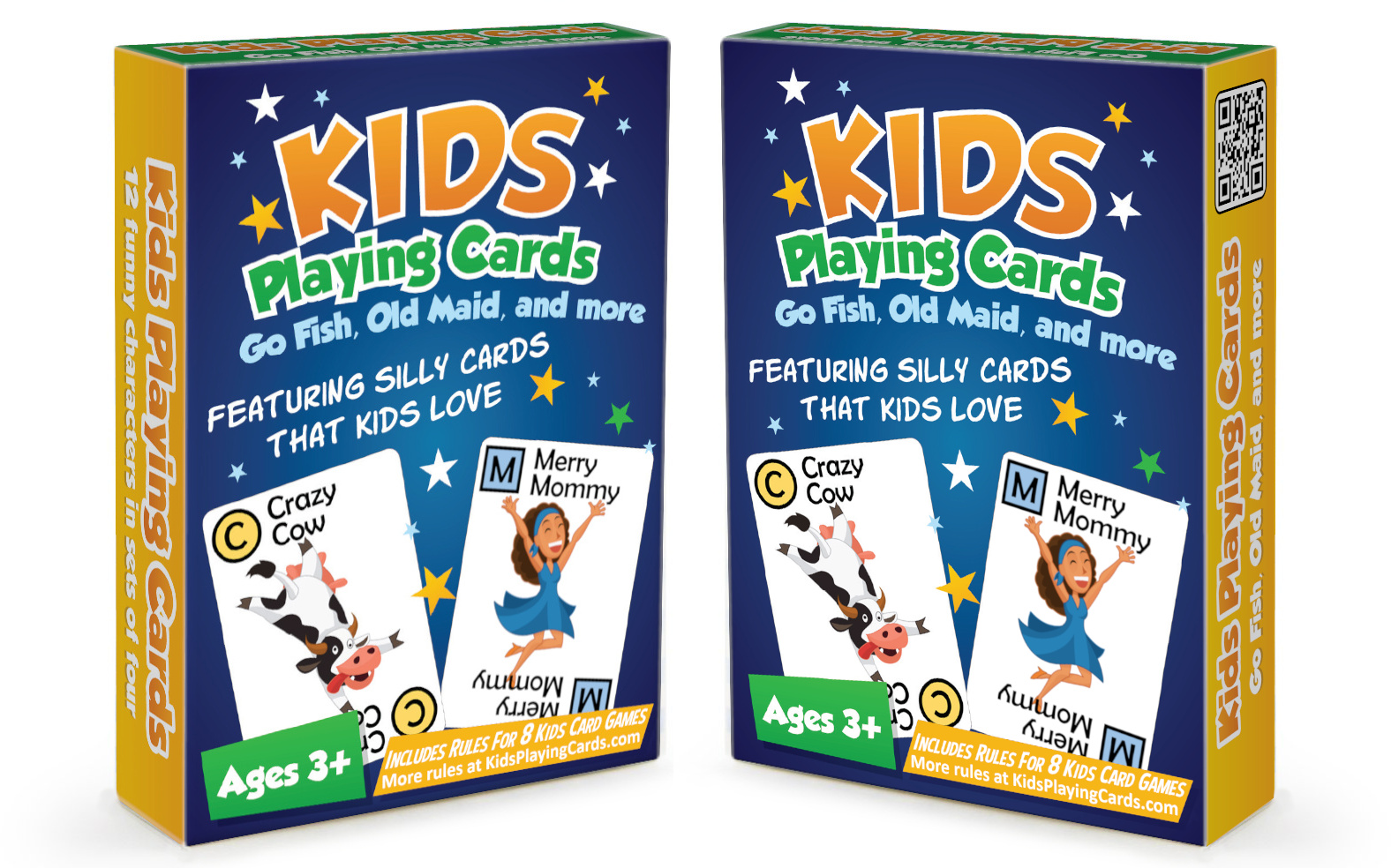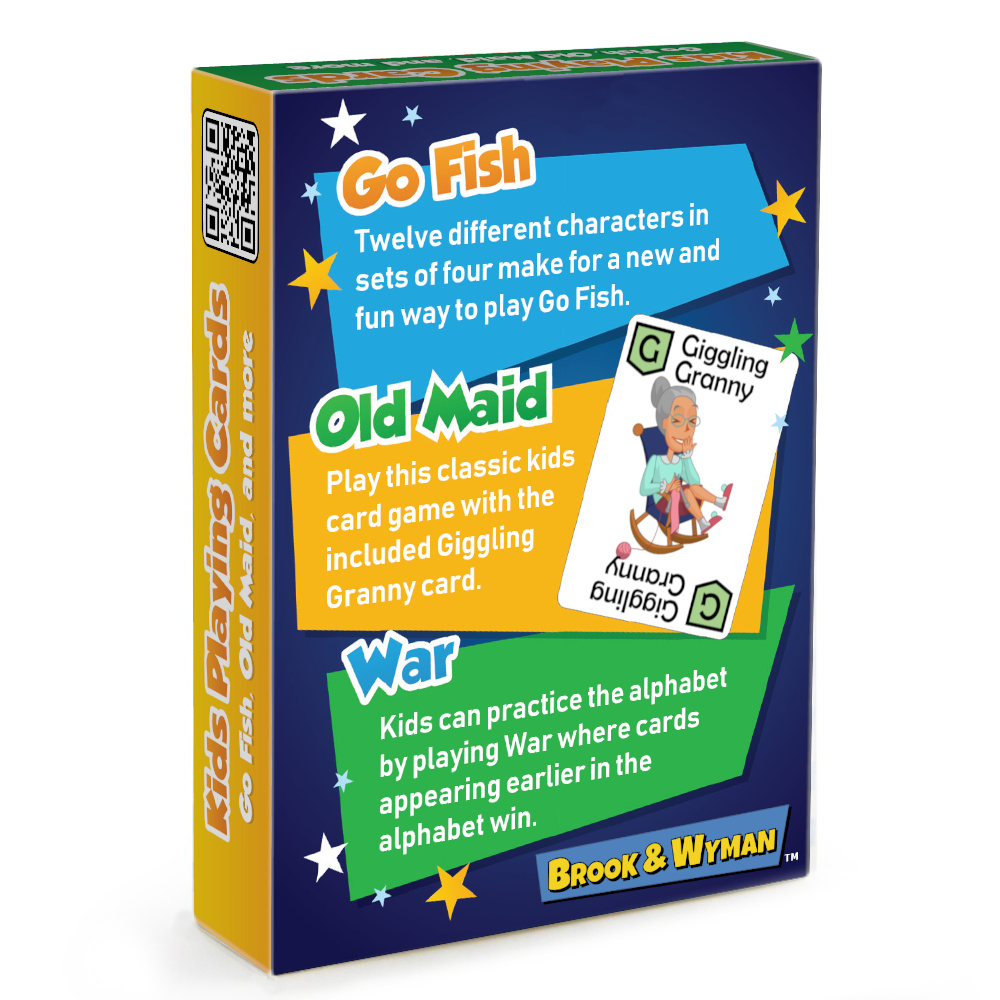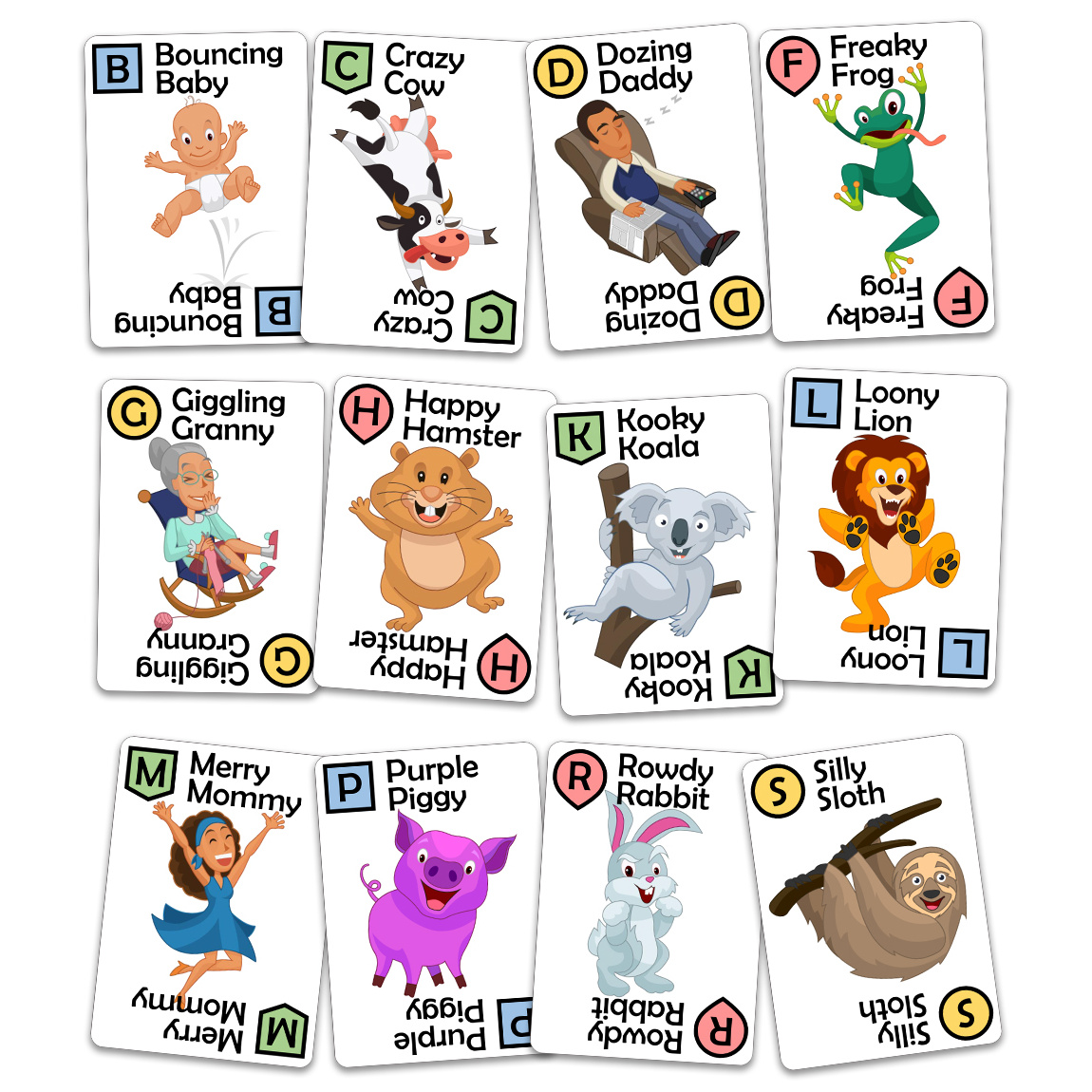1 Go Fish

Go Fish
Two or more players
The dealer shuffles the deck and gives seven cards to each player, six cards if there are three players, or five cards if there are four or more players. The remaining cards are placed face down into a loose pile at the center of the table.
Each player will try to assemble as many sets of four characters as they can. The player to the left of the dealer starts by asking one other player whether he or she has a particular character card (for example, “Alex, do you have any Dozing Daddies?”). The asking player must already have at least one of the character cards he or she is asking for. If the asked player has any of those cards, he or she must give the asking player all of them, and the asking player may continue by again asking any player for any character.
If the player being asked does not have the character requested, he or she says “Go Fish” and the asking player must then draw one card from the center pile. If the player draws the card he or she was asking for, the player must show that card and may continue asking other players for cards. If the player draws any other card, the turn then passes to the next player on the left.
Whenever players assemble four cards of the same character, they place the completed set face up in front of them. The game ends when either the draw pile is gone, or one player has no more cards left. The player who has the most completed sets when game ends wins.
2 Old Maid

Old Maid
Three or more players
First, remove one of the Giggling Granny cards from the deck. Starting with the player to the left, the dealer then hands out all cards to the players face down. Players then pick up their hands, identify any character pairs, and place these pairs face up in front of them.
The player to the dealer’s left then draws one card from the cards in the dealer’s hand. The player taking the card must not be able to see the cards. After players draw a card, they lay down a new matching pair if they can, and then offer their cards to the player on their left, who must take one card.
The player who is holding the unmatched Giggling Granny card at the end loses the game.
3 Crazy Cows

Crazy Cows
Two or more players
With Kids Cards, the classic card game Crazy Eights is played as Crazy Cows. First, the dealer gives each player eight cards. The remaining cards are placed face down in the center of the table and become the draw pile. One card is taken from the draw pile and placed face up beside the pile. This becomes the discard pile.
Starting with the player to the left of the dealer, players discard one card that has either the same character or the same color as the top card on the discard pile. If a player doesn’t have a card with the same character or color, that player must pick up cards one at a time from the draw pile until a playable card is drawn, and then discard it.
Crazy Cows are wild cards, so they can be played regardless of what card is on top of the discard pile. When a player discards a Crazy Cow, he or she must choose any color for the next player to match. For example, if a green Kooky Koala is on top of the discard pile, a player may discard a blue Crazy Cow and say “the color is red”. The next player must then discard a red card or another Crazy Cow.
If the draw pile runs out, take all but the top card in the discard pile, shuffle them, and use them to create a new draw pile. The first player to discard all of his or her cards wins.
4 Rummy
 Rummy
Rummy
Two to six players
The dealer shuffles the deck and gives ten cards to each player, seven cards if there are three or four players, or six cards if there are five or six players. The remaining cards are placed face down in the center of the table and become the draw pile. One card is taken from the draw pile and placed face up beside that pile. This becomes the discard pile.
Players try to arrange their cards into sets consisting of three or four cards of the same character or the same color. The player to the left of the dealer starts, and must take either the face-up card from the discard pile or a face-down card from the draw pile. That player must lay out face up any sets he or she can assemble. The player then chooses one of his or her cards to place face up on the discard pile, and the turn passes to the next player on the left.
At any time during their turns, players may add cards to any of their existing sets. For example, if a player had earlier placed down three Merry Mommies and later draws the fourth, he or she may add that card to their set. The first player to place all of their cards into sets wins that round. The first player to win five rounds wins the game.
5 Memory

Memory
Two or more players
Shuffle the cards and then lay all of them out in a rectangular pattern face down. A good pattern might be six cards high by eight cards wide.
The player to the left of the dealer randomly turns over one card, and then a second card. If the characters match, the player takes the two matching cards and may turn over another two cards. If they don’t match, the player turns the cards back over and the next player to the left takes a turn. Be careful to replace the cards in the same position.
The player with the most pairs when all cards are gone from the center of the table wins.
6 I Doubt It
 I Doubt It
I Doubt It
Three or more players
The dealer shuffles the cards and deals out all of the cards (if 5 players, take 3 cards out of the game, if 7 players, 6 cards – this is so all players will have an even number of cards). The player to the left of the dealer places two cards in the discard pile face down and must always claim they are two matching characters, for example by saying “Two Kooky Koalas”. But the cards may or may not actually be that character.
Any other player may challenge by saying “I doubt it”. The person who played the cards must then turn over the two cards he or she just played. If the person who played the cards was lying, that player must add the discard pile to his or her hand. If the player was not lying, the challenger must take the discard pile. The turn then passes to the next player on the left.
The first player to run out of cards wins.
7 Spoons

Spoons
Three or more players
The dealer shuffles the deck and gives four cards face down to each player. The remaining cards are placed face down to the left of the dealer and become the draw pile. Spoons are placed in the center of the table, one spoon less than the number of players.
The goal is to collect four of the same character. The dealer takes one card from the draw pile and then passes any card face down to the player on his or her left. That player then takes that card, and passes any card to the next player on the left. When the turn comes to the player to the right of the dealer, that player discards their card face down, starting a discard pile to the right of the dealer. The dealer, rather than taking the discarded card from the player on his or her right, takes a new card from the draw pile. He or she then passes any card face down to the player on his or her left, and play continues.
When a player assembles a complete set of four characters, he or she takes a spoon from the center of the table (it’s fun to try to be sneaky when taking the spoon) and everyone else then tries to grab a spoon. The person who is left without a spoon is out of the game. All cards are then re-shuffled, four new cards are dealt to each remaining player, and another round begins, again with one less spoon than players. The last player remaining wins the game.
8 Pig

Pig
Three or more players
This game is similar to Spoons, but you don’t need anything other than the cards and if you lose a round, you’re not eliminated right away. The dealer shuffles the deck and gives four cards face down to each player. The remaining cards are placed face down to the left of the dealer and become the draw pile.
The goal is to collect four of the same character. The dealer takes one card from the draw pile and then passes any card face down to the player on his or her left. That player then takes that card, and passes any card to the next player on the left. When the turn comes to the player to the right of the dealer, that player discards their card face down, starting a discard pile to the right of the dealer. The dealer, rather than taking the discarded card from the player on his or her right, takes a new card from the draw pile. He or she then passes any card face down to the player on his or her left, and play continues.
When a player assembles a complete set of four characters, that player touches his or her nose. When the other players see this, they must all touch their noses as well. The last player to touch his or her nose gets one letter towards spelling pig. All cards are then re-shuffled, four new cards are dealt to each remaining player, and another round begins. The first player to spell out pig loses the game.
9 War

War
Two or more players
The dealer hands out all cards to all players. All players stack their cards face down, take their top card, and place them face-up in the center of the table at the same time. The player with the card coming earliest in the alphabet takes the cards from the middle and adds them to the bottom of their stack. For example G beats S, and B beats G.
If two or more players play the same character (and, if there are more than two players, that character is a winner) players play one face-down card in addition to the usual face-up card until a player wins the pile. The game is won when one player has all of the cards. A player can also lose by running out of cards during play before the pile is won.
10 Slap Sloth

Slap Sloth
Two or more players
With Kids Cards, the classic card game Slapjack is played as Slap Sloth. The dealer hands out all cards face down -- don’t worry if the number of cards is uneven. Players leave their cards face-down in front of them.
The player to the left of the dealer takes their top card and places it face-up in the center of the table. The next player to the left adds another card to the center pile face-up, and so on. If a Silly Sloth card is played, all players must try to slap the center pile, and the first player to do so takes the cards and adds them upside-down to the bottom of their pile.
If a player runs out of cards, he or she has one more chance to stay in the game by being the first to slap the center pile when a Silly Sloth is played. If he or she is not the first, that player is eliminated and play continues until one player has all of the cards, and wins the game.
11 Snap

Snap
Two or more players
The dealer hands out all cards face down -- don’t worry if the number of cards is uneven. Players leave their cards face-down in front of them.
The player to the left of the dealer takes their top card and places it face-up in front of him or her, and then the next player to the left does the same, and so on. When two players flip over the same character card in a row, all players in the game shout snap. The first player to call snap wins the face-up cards from the two players who turned over matching characters. Play continues until one player wins all of the cards.
12 Bundles

Stealing Bundles
Two to Four players
The dealer gives four cards face down to each player, and places four cards spaced out and face-up in the center of the table. If the player to the left of the dealer has one of the face-up cards, he or she may take that card from the center and lay down the matched pair face up in front of him or her, starting their matched-pair pile, called a “bundle”. If that player doesn’t have one of the face-up cards, he or she must add a face-up card from their hand to the middle.
The next player to the left may do one of those same two things, but may also steal the first player’s bundle by playing the same character on top of it. When a bundle is stolen, it is added on top of the stealing player’s bundle.
Play continues around the table. If a player runs out of cards, the dealer gives him or her four more. If the middle face-up cards run out, the dealer adds four new face-up cards there. When the dealer runs out of cards, everyone counts their cards, and the player with the most cards wins.
13 Authors
 Authors
Authors
Three to Five players
This game was originally played with decks containing cards showing the works of different authors, but any deck with cards in sets of four will work. The dealer hands out all cards face down -- don’t worry if the number of cards is uneven.
Players try to assemble as many sets of four matching characters as they can. The player to the dealer's left begins by asking any player for a specific card, for example “Do you have the Green Kooky Koala?” The asking player must have at least one of the character he or she is asking for. If the player gets the card he or she asked for, that player may ask again. If the player does not get the card asked for, the turn passes to the next player on the left.
When a player collects four matching characters, the player places them face-up on the table. If a player runs out of cards, he or she is out of the game. When all cards have been played, the player with the most sets of four wins. Ties are possible.










 Rummy
Rummy
 I Doubt It
I Doubt It





 Authors
Authors